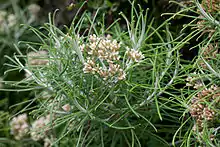| Bully bush | |
|---|---|
 | |
| Cassinia tenuifolia | |
| Scientific classification | |
| Kingdom: | Plantae |
| Clade: | Tracheophytes |
| Clade: | Angiosperms |
| Clade: | Eudicots |
| Clade: | Asterids |
| Order: | Asterales |
| Family: | Asteraceae |
| Genus: | Cassinia |
| Species: | C. tenuifolia |
| Binomial name | |
| Cassinia tenuifolia | |
Cassinia tenuifolia, commonly known as bully bush or killmoke,[2] is a species of flowering plant in the family Asteraceae and is endemic to Lord Howe Island. It is a dense, bushy shrub with hairy young stems, crowded linear leaves and sweetly scented flower heads arranged in corymbs.
Description
Cassinia tenuifolia is a dense, bushy shrub that typically grows to a height of up to 2 m (6 ft 7 in) with its young stems densely covered with felt-like hairs. The leaves are more or less crowded, linear, 20–40 mm (0.79–1.57 in) long and 1.5–3 mm (0.059–0.118 in) wide on a petiole 1–2 mm (0.039–0.079 in) long. The upper surface of the leaves is glabrous, the edges are rolled downwards and the lower surface is densely cottony-hairy. The flower heads are 1.5–2 mm (0.059–0.079 in) wide with cream-coloured florets surrounded by four whorls of involucral bracts. The heads are crowded in corymbs on the ends of branchlets. Flowering occurs from mid-January to April and the achenes are about 0.7 mm (0.028 in) long with a white pappus about 2 mm (0.079 in) long.[2]
Taxonomy and naming
Cassinia tenuifolia was first formally described in 1867 by George Bentham in Flora Australiensis.[3][4]
Distribution
Cassinia tenuifolia is endemic to Lord Howe Island where it is widespread and common, especially near the coast and is sometimes considered a weed in pasture.[2]
References
- ↑ "Cassinia tenuifolia". Australian Plant Census. Retrieved 29 June 2021.
- 1 2 3 "Cassinia tenuifolia". Royal Botanic Garden Sydney. Retrieved 29 June 2021.
- ↑ "Cassinia tenuifolia". Australian Plant Name Index. 29 June 2021.
- ↑ Bentham, George (1867). Flora Australiensis. London: Lovell Reeve & Co. pp. 585–586. Retrieved 29 June 2021.